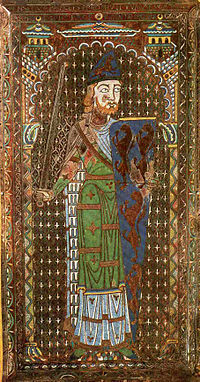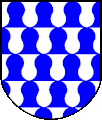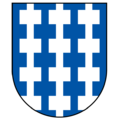Vair: Difference between revisions
→Trivia: why must every mistaken belief be an *urban* legend? |
No edit summary |
||
| Line 39: | Line 39: | ||
==Cinderella's slippers== |
==Cinderella's slippers== |
||
It is widely believed that [[Charles Perrault|Perrault]]'s version of the fairytale "[[Cinderella]]" was mistranslated into English. The story says that the original French had the slippers made of ''vair'' (fur), which was misread as the [[homophone|homophonous]] ''verre'' (glass).<ref>One example: {{cite book |title=A Glossary of Terms Used in Heraldry: Vair|last= Parker|first= James|year= 1894|url= http://www.heraldsnet.org/saitou/parker/Jpglossv.htm#Vair|accessdate=9 June 2011}}.</ref> This story has been debunked.<ref>{{cite web |url=http://www.snopes.com/language/misxlate/slippers.asp |title=Glass Slippers |last1= Mikkelson|first1= Barbara |last2= Mikkelson|first2=David |date=12 July 2007 |accessdate=9 June 2011}}</ref> |
It is widely believed that [[Charles Perrault|Perrault]]'s version of the fairytale "[[Cinderella]]" was mistranslated into English. The story says that the original French had the slippers made of ''vair'' (fur), which was misread as the [[homophone|homophonous]] ''verre'' (glass).<ref>One example: {{cite book |title=A Glossary of Terms Used in Heraldry: Vair|last= Parker|first= James|year= 1894|url= http://www.heraldsnet.org/saitou/parker/Jpglossv.htm#Vair|accessdate=9 June 2011}}.</ref> This story has been debunked.<ref>{{cite web |url=http://www.snopes.com/language/misxlate/slippers.asp |title=Glass Slippers |last1= Mikkelson|first1= Barbara |last2= Mikkelson|first2=David |date=12 July 2007 |accessdate=9 June 2011}}</ref> |
||
===Other furs=== |
|||
German heraldry recognizes a fur called ''Kürsch''; this is said to be drawn brown and hairy, and there are occasional references in English to "vair bellies", which may be the same thing. ''Plumeté'' is a feather-like pattern of exceptionally rare appearance which is placed in the category of furs. It can be used essentially (though not technically) as a type of patterned field.<ref>{{cite web|title=The Public Register of Arms, Flags and Badges of Canada - Heraldry: Leslie Graham Cairns MILLIN|url=http://www.gg.ca/heraldry/pub-reg/project-pic.asp?lang=e&ProjectID=323&ProjectElementID=1106|accessdate=2007-08-13}}</ref> "Plumetty d'aigle proper" is distinguished in at least one case, though the tincture in this case is a form of proper.<ref>{{cite web|title=RHSC Roll of Arms - Rodunksy|url=http://heraldry.ca/arms/r/rodnunsky.htm|accessdate=2008-07-04}}</ref> ''Pappeloné'' is a pattern supposed to resemble the scales on the wings of a butterfly{{Citation needed|date=June 2008}}. |
|||
<gallery> |
|||
File:Blason de la ville de Mérignies (59) Nord-France.svg|Plumeté Or and sable |
|||
File:Kursch.gif|Kürsch |
|||
</gallery> |
|||
==See also== |
==See also== |
||
Revision as of 23:58, 12 July 2011

Vair (from Latin varius "variegated") is the heraldic representation of patches of squirrel fur in an alternating pattern of blue and white. As a tincture, vair is considered a fur and is therefore exempted from the Rule of tincture (i.e. it can be placed upon a metal, a colour, or both). Variations of vair are laid out in different patterns, each with their own name. Vair may also be differently coloured, but this is blazoned as "Vairy of [tincture] and [tincture]", where one tincture must be a metal and the other a colour.
Origins
The word vair, with its variant forms veir and vairé, was brought into Middle English from Old French, from Latin varius "variegated",[1] and has been alternatively termed variorum opus (Latin, meaning "variegated work").[2] The Swedish term gråverk is analogous.
The squirrel in question is a variety of the Eurasian Red Squirrel, Sciurus vulgaris. In the coldest parts of Northern and Central Europe, especially the Baltic region, the winter coat of this squirrel is blue-grey on the back and white on the belly, and was much used for the lining of cloaks called mantles. It was sewn together in alternating cup-shaped pieces of back and belly fur, resulting in a pattern of grey-blue and grey-white which, when simplified in heraldic drawing and painting, became blue and white in alternating pieces.[2]
-
Dark morph of Eurasian red squirrel
-
Vair-lined mantles in the 14th century Codex Manesse
Variations

In the oldest records vair is represented by means of straight horizontal lines alternating with wavy or nebuly lines (sometimes blazoned as vair ondé or vair ancien); this is seen in the lining of the cloak depicted on the tomb of Geoffrey V of Anjou (see image).
A vair-like pattern of tinctures other than argent and azure is referred to as vairy (or vairé) of [metal] and [colour]. Other differently tinctured patterns are called counter-vairy, potenty or counter-potenty of [metal] and [colour], though these are rare. A few instances can be found of vairy of four tinctures, but this is very rare.
The height of a row of vair is not strictly specified, but is typically about one-fifth that of the shield. Where there are more than six rows, the term menu-vair may be used. This is the origin of the English word "miniver", which was the general word for the fur lining used for robes of state.
Vair of fewer than four rows is sometimes called beffroi (a French cognate of belfry), probably from the resemblance of a piece of vair to a church tower. The word derives from Old French berfroi and Old High German bergfrid, "the one who guards the peace". Originally, a beffroi was a wheeled tower which was used for scaling the walls of a besieged city, similar in shape to the pieces of vair. Later, it was used for a watchtower, and then for any tower where a bell was hung. Vair of two rows, called gros-vair, is also occasionally seen.
Potent
Potent is a fur in heraldry. It is like vair, except using a T-shaped item instead of the vair bell. (The word "potent" means crutch; it is thought to derive from badly-drawn vair.) It is subject to all the subvarieties of vair, thus counter-potent and so on.
-
Vair, modern style -
Vair ancien -
Counter-vair -
Vair in pale -
Vair-en-pointe -
Potent -
Counterpotent -
Potent-en-pointe
Cinderella's slippers
It is widely believed that Perrault's version of the fairytale "Cinderella" was mistranslated into English. The story says that the original French had the slippers made of vair (fur), which was misread as the homophonous verre (glass).[3] This story has been debunked.[4]
Other furs
German heraldry recognizes a fur called Kürsch; this is said to be drawn brown and hairy, and there are occasional references in English to "vair bellies", which may be the same thing. Plumeté is a feather-like pattern of exceptionally rare appearance which is placed in the category of furs. It can be used essentially (though not technically) as a type of patterned field.[5] "Plumetty d'aigle proper" is distinguished in at least one case, though the tincture in this case is a form of proper.[6] Pappeloné is a pattern supposed to resemble the scales on the wings of a butterfly[citation needed].
-
Plumeté Or and sable
-
Kürsch
See also
References
- ^ "Vair". American Heritage Dictionary of the English Language, 4th ed. New York:Houghton Mifflin Company. 2000.
- ^ a b Veale, Elspeth M.: The English Fur Trade in the Later Middle Ages, p. 224.
- ^ One example: Parker, James (1894). A Glossary of Terms Used in Heraldry: Vair. Retrieved 9 June 2011..
- ^ Mikkelson, Barbara; Mikkelson, David (12 July 2007). "Glass Slippers". Retrieved 9 June 2011.
- ^ "The Public Register of Arms, Flags and Badges of Canada - Heraldry: Leslie Graham Cairns MILLIN". Retrieved 2007-08-13.
- ^ "RHSC Roll of Arms - Rodunksy". Retrieved 2008-07-04.
This article incorporates text from A. C. Fox-Davies' 1914 edition of Charles Boutell's
- The Handbook to English Heraldry at Project Gutenberg, which is in the public domain in the United States.
- Veale, Elspeth M.: The English Fur Trade in the Later Middle Ages, 2nd Edition, London Folio Society 2005. ISBN 0900952385
- comment about the double translation in Cinderella












